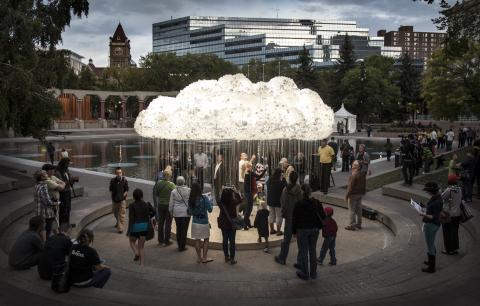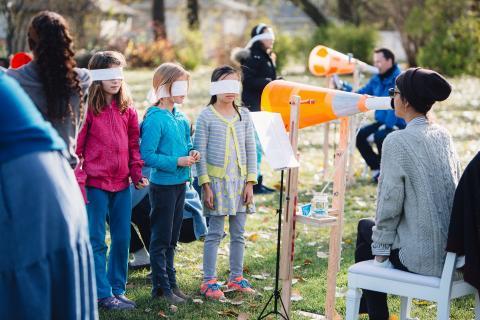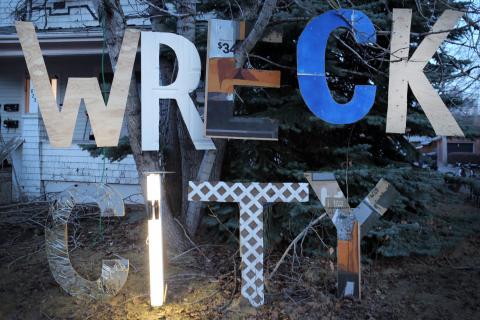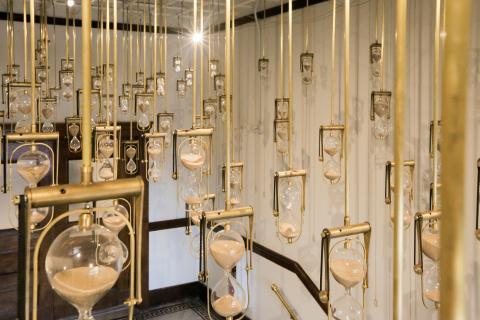2019 TD Insurance Meloche Monnex Career Award for Alumni
INTERVIEW BY KERRY MAGUIRE, BFA '18

CLOUD, Caitlind r.c. Brown & Wayne Garrett, 2012. Light bulbs, steel, electronics, pull chain switches. Participants pull on/off switches to animate "lightning" on the CLOUD’s surface. Chaos and harmony between people elicits different responses. Commissioned for Nuit Blanche Calgary. Photo by Mitch Kern
KERRY MAGUIRE: What projects are you working on right now?
CAITLIND R.C. BROWN: We’ve [Wayne Garret and I] have so many installs this month! A primary part of my practice is collaborating with other people. It’s essential to my practice, so much so that it’s important for me to clarify often that I am an artist and a collaborator. I’ve made collaborating my mandate and a personal motivation.
Right now we have a few installs and a few public art projects underway. One was scheduled to go in over the summer, but has sort of shuffled into October. We have two installs in Calgary and one in Toronto, and then we are going to Halifax for a light festival called Responsive that should be great. It’s a co-presented festival between Cologne, Germany and Halifax. We’re installing our door frames piece, The Deep Dark. It should be an interesting spot for it! So I would say that right now life is dominated by coordinating public art installs.
We are going into a phase right now that’s really exciting where we get to start applying for opportunities again. That’s always been my favourite part: generating concepts and thinking about site. We’re getting better at being site-specific which is exciting and fun; we are learning how to navigate and understand a space as someone who doesn’t necessarily live in that space. This means allowing enough space for the specific public of a place to inform an artwork, which is what is important to me right now.
MAGUIRE: Where did this collaborative root come from? I know that someone you collaborate with often is Wayne Garrett, who is a musician. I think that collaboration is built into music almost by default in a way that it’s maybe not built into art practices.
BROWN: I definitely learned how to collaborate at art school, at AUArts. To me, it seemed to be a necessity… you often don’t have enough resources or enough hands to accomplish what it is that you feel you need to do. I started collaborating there, and I continue to find it deeply motivating to collaborate. I see it in bands for sure, and I have a faint jealousy toward that [laughs] and I definitely feel like that is what makes Wayne such a great collaborator. And of course there are many other factors that make it ideal, like spreading the wealth and spreading the responsibility in a manageable way.
MAGUIRE: I have a few specific questions about your time at AUArts… first of all, do you remember how you ended up at AUArts?
BROWN: I was very close between going into creative writing and going to art school. The tipping point actually came from getting this amazing scholarship from AUArts. It was a scholarship that was so magical… they only awarded it twice. I was unbelievably lucky as it covered my entire tuition for four years. That was the perfect motivation to go to AUArts, though my interest in art school was an ongoing interest.
I had an art teacher in high school who had gone to art school at the University of Calgary. I honestly didn’t even know [art school] was a possibility until then. This is certainly a thing of privilege, but I never really regarded an art education as a necessary step toward a career. To be more specific, I approached it as a way to develop my thinking. I saw AUArts as a way to learn how to think. There are other directions that would be more fruitful if what you wanted was a steady job… for example, Wayne is a musician, and what he was always told was to learn a trade, then he could do both music and that trade and always have paid work.

Without Eyes, Lane Shordee, Nikki Martens, and Caitlind r.c. Brown, 2016. Found materials, wood, text. Performers sit in a ring, reading aloud. Viewers are blindfolded, and brought into the ring to listen to voices move in and out of sync as they walk around. Presented at M:ST Performance Art Festival. Photo by Diane + Mike Photography.
I always knew that art school wasn’t, let’s say, 100% practical. There are other paths I could have gone if I was interested in a steady job, but I wanted the theoretical knowledge inherent in an arts education. You can choose to develop a skill set that is unique to you or one that is universally applicable. I actually think that you need a balance of those two things.
Art school was almost… an investment in magical thinking. If you go to art school, you will essentially learn how to think. From that, you get all of these wonderful derivatives: you learn how to collaborate, you learn how to step laterally between disciplines, and you learn that certain things that might be taught to you in other methods of schooling might not be so important, you know? For example, grades… the people who got the best grades in art school weren’t necessarily the people who went on to have strong artistic practices. They might have tended more to getting further education, or something along those lines. But I remember having that moment at AUArts where I realized, “Now I know how to think better.”
MAGUIRE: Is there a moment in art school that changed the course of your practice and education? Or a slower change that you can trace? I’m specifically interested in your dedication to collaborating, where that came from.
BROWN: For sure. Particular people in school were really important to my education, especially peers. For example, Lane Shordee was really important in my education. Kali Urquhart was a key moment in my education. I think for most people, most key moments would come from teachers. I had really excellent, exceptional teachers at AUArts, but I still feel that my peers were much more important in ultimately guiding me to the path I wanted to pursue.
There was a studio we had in third year… well, to start, I feel like everyone in third year has a crisis! It’s inevitable, it’s the time for it. It will happen. So during our “third year crisis” this arbitrary group of us — me, Lane, Kali, Sage Wheeler — were assigned to this small studio on the 5th floor, between drawing and design. There were no windows, which I was not excited about at first, but that studio ended up being the best thing that happened to me.
Having this smaller environment of peers, and having the freedom of filling that smaller space… people kind of forgot we were there, so we had the freedom to do things that maybe wouldn’t be so easy in the more visible spaces. Things like filling the studio with leaves, or Lane built this beautiful table in the middle of the room. The table was also a gallery, and you could pull the legs out from above. There were compartments built in, and he programmed exhibits of different people’s artworks into the compartments. Maybe it was a bit utopian, we all could forget about the rest of the world while we were up there.
It was right around then that I was getting into film. I wanted to use my studio space to its full advantage, because my practice was sort of invisible. My practice was mostly happening elsewhere, at the Calgary Society of Independent Filmmakers (CSIF), so I didn't really need my studio space in the same way other folks did. So I started doing weekly performances. They were sometimes installations, sometimes participatory. Every week the studio would change completely change in aesthetic, and people from all over the school would be able to jump in a pile of leaves, or eat some birthday cake while we serenaded them. Basically I was learning that if you choose to share your space, it can radically change over very small intervals of time.
MAGUIRE: I'm sure that since graduating in 2010, you have had some time to evolve. In what ways has your practice changed since then?
BROWN: It has for sure, maybe inevitably, changed since then. Right after AUArts I was working for artist-run centres in Calgary like Quickdraw Animation Society, and for places like Fairy Tales Film Festival and CJSW 90.9 FM. All of those jobs were great insights into the world of art and music administration, as well as festival administration. I was living at the Arbor Lake Sghool during the last six months of art school, which was the perfect place to be while transitioning to the life of an artist. It was a place where anything was possible. They weren’t that concerned about riskiness, danger; there were lots of power tools [laughs]. It was very physical, which was great in opposition to working somewhere like Quickdraw, where I was slowly planning the GIRAF festival, and then having this one intense week where the festival actually happened. With something like GIRAF, you are thinking about audience, about critical mass.
That thinking led into curation — curation in a DIY fashion. The House Project was an artist-curated space at a house in Kensington that was slated for demolition. It made it clear to me that I found spaces more interesting than things. If you can build a space — you can think about a space as an event, or as an artwork that other people can contribute to, like Lane’s table. I found that it was possible to build spaces, and that those were collaborative circumstances. But there’s also room for individual voice. The House Project is what led into Wreck City.

WRECK CITY Sign, Caitlind r.c. Brown & Wayne Garrett, 2013. Domestic debris. Signage for WRECK CITY: an epilogue for 809 in Calgary. www.wreckcityproject.wordpress.com
MAGUIRE: To be honest, I think that the first Wreck City is the thing that made me want to be an artist. I was never really exposed to much art growing up, and had just completed a biology degree. Somehow I ended up at Wreck City and it totally changed my perception of what art could be. It was this magical chaos that I had never imagined. Whenever I try to explain it to people — there was a hole in the ceiling! A bridge from one house to another! — it’s impossible.
BROWN: It was… there’s nothing really like it. We have had other iterations of Wreck City since then, but nothing will ever be quite like that first one: an entire art neighbourhood. I think it was before Instagram was such a big thing. We didn’t know if anyone would come, we had a little press but that was all. It ended up having this enormous draw, and I remember going for a coffee in Kensington. The barista was talking to someone in front of me in line, explaining this project that seven other people and I had created.
It’s easy for me to see how DIY curation and Wreck City link to public art. There is an interest I have in the public, and how art can fit into the everyday and the experience of a place. Not as a single entity, but as something holistic and considerate of the surrounding people, history, and geography, or at least you try to be. Two really different aspects of public art that I love are site specificity and uncertainty. You can plan as much as possible, and try to embed yourself in the surrounding area, but there are always things you won’t know about until the artwork happens.
There’s what I think is a delusion that you have complete control over what you are making and what you are building. As soon as you let that notion go, you allow so much more space for other people. Being concise and clear is important, but that openness is important. Maybe it’s specific to Calgary, I do acknowledge that we rely a lot on our city. And our friends!
I had this moment this year where I became aware of one friend in particular that has helped with all of mine and Wayne’s projects, every Wreck City: basically, at every important art moment I’ve had in the last decade, Svea Ferguson has been there to help. The moment I became aware of that was at our friend Matt’s (Matthew Mark Bourree] funeral; it was this moment of loss, and acutely realizing how much this person you have lost has contributed to your world. Then I looked around and was aware of how much the other people present have contributed as well.

Yesterday, Today, Tomorrow, Caitlind r.c. Brown, Wayne Garrett, and Lane Shordee, 2018. Hourglasses, sand, electronics, motor, micro-computer, brass. Designed for cSPACE King Edward (a historic sandstone school turned art space), 105 hourglasses rise in a cloud over the main grand entrance, flipping at different intervals. Some hourglasses measure universal time, and others measure personal time, gathered from members of the community. Sand was crushes from sandstone bricks collected from the building. www.yesterday-today-tomorrow.org
MAGUIRE: What does a day, week or month in your life look like? It seems that you are mostly working in public art at the moment.
BROWN: This week, we got all of the Wreck City books. This book was a year in the making, and it’s specifically about the third Wreck City, theWreck City Residency. It’s full of photos and writing from many different people, and I designed it. It's so exciting to finally hold it.
This week, we’ve also gone to meetings with the City of Calgary trying to figure out our Wandering Island project that Wayne, Lane and I are leading. There are several artists that are making permanent work for the island (Elbow Island in Calgary) so we’ve been on site with hard hats and steel toed boots, tromping around in the mud. Logistically, it’s been an absolute mess, there’s been so much bureaucracy, which has led us to these moments where we’ve felt like we’re letting down other artists. We’re trying to negotiate this project with the city in a way to make it easier for other projects with other artists happen in the future, to make it less cumbersome and prohibitive, by setting a precedent.
Last night we were up late building a sign for this archway we are installing at cSPACE. It says “King Edward School." It’s a 30 foot wireframe sculpture, a version of this sandstone archway on the King Edward School building itself.
On Monday morning we shipped off The Deep Dark door frames to Halifax, which we had to build fresh. It was all packed in a 700-pound crate that we were sort of hilariously pushing out of the garage door, wheeling it on to the tailgate of a truck in our back alley! So, you can see that all these projects are very much happening at the same time.
When people ask, “What’s new?” or, “What are you working on?” I’m like… can I just say multitasking? [Laughs]. I am also currently working on a proposal for this really cool design competition in Winnipeg. It’s supposed to be for architects, but... I don’t know! It’s competitive, but might as well try.
With everything an artist does that is uncomfortable… I’ve been given the advice so many times to literally fake it until you make it. There’s something radical about being the person who shouldn’t be doing that thing. With curation, for example — I feel kind of strange to be holding or owning that title. Like with any pursuit, curation has rules. But a lot of artists have decided to step into the role of curator, especially in Canada, where there maybe aren’t as many curators, or they are less accessible to emerging artists. Curators are the people who, ideally, provide context to your work. Maybe in bigger Canadian cities, or in the United States or Europe, it’s harder to understand the lack of access we have to curators, and the need for artists to fill that role themselves.The danger of doing all the contextualizing yourself is perpetuating your own delusions. It’s great to have someone else writing your bio, or writing about your work, because maybe you have got into the habit of talking about something that was once true about yourself, and isn’t anymore.
On the other hand, in winning this Alumni award, I am grateful but also want to acknowledge that no one deserves anything; what I mean by that is there are going to be so many amazing people who work so hard and never get this kind of recognition. I think it’s the same deficit as we have in art writers or curators; something, like this award, that we can give artists to help get them to the next step of their career. I think a really great professor does that, they are the intermediary between an artist and their potential future. I feel like Mireille Perron, who nominated me and the past three people who have won this award, is a person who does that. I am so grateful for her support!

Kites for Still Nights, Caitlind r.c. Brown & Wayne Garrett, 2019. Helium balloons, fishing line, tulle. Created for The Hibernation Project, a 12-week domestic intervention designed to ferry artists through the winter, this piece was flown over the Inglewood Wetlands on a cold winters night. www.hibernationproject.home.blog
>>> Meet other Alumni Awards recipients
See Caitlin's Instagram
